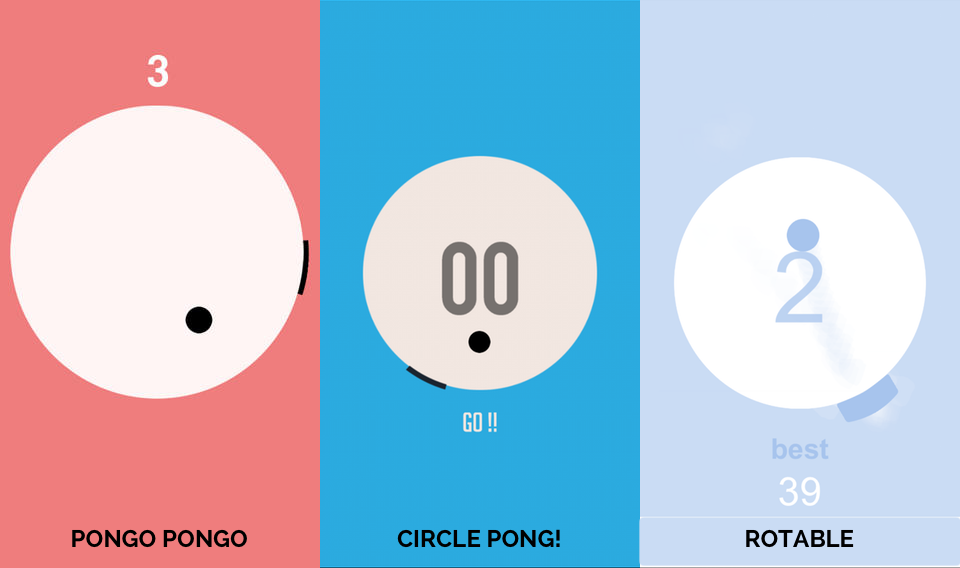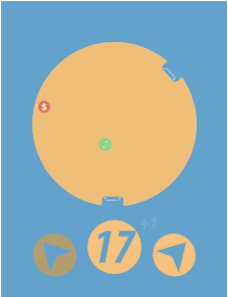
Featured Blog | This community-written post highlights the best of what the game industry has to offer. Read more like it on the Game Developer Blogs or learn how to Submit Your Own Blog Post
We made a "pong-in-a-circle" app too, before rotable and circle pong and I think I now why
A lot of mobiles games look the sames / are clones / are inspired by other apps. But sometimes two different developers can create very similar games without knowing it. Here are my two cents on why this happens.

Quick Update for those of you who don't know what I'm talking about :
This week, someone made a claim that his game, Rotable, had been stole by a company (Ketchapp), cloned and released with a different company (App Cow) with an other name : Circle Pong.
The article is here : The 2048 guys stole my iPhone game
Just after, an other article came out, saying that Circle Pong was in fact not stolen by App Cow, but was a clone of an app released in April 2014 called Pongo Pongo.
The second article is here : Was 'Circle Pong' a Ketchapp Clone of Another Game? Signs Point to No.

Now here we are.

I'm Samy Badache and I am one half of the indie studio DuckyGames and we released in January our first real game called Save The Puck on Android and iOS :
The game was released in January but we started to work on it during the last summer (we worked on it after work hours as a personal project).
We didn't show a lot of it at that time but you can search on our twitter account to find some early screenshots of the game :
"Save The Puck !" This is the name of our next game ! And in this game you can lose ! Sorry ... #gamedev #indiedev pic.twitter.com/HjHreslBhm
— Ducky Games (@Ducky_Games) October 29, 2014
Save The Puck is a pong-in-a-circle app too...
There is no way we could have seen Circle Pong or Rotable back then because they weren't released at that time.
Pongo Pongo was however released before we started Save The Puck.
We never heard about Pongo Pongo before and if we had at the time, when we worked on Save The Puck, we would have probably decided to stop working on it (or making drastic changes to the game).
Of course, there is always the possibility for us to have seen Pongo Pongo before, forget about it and after that remade it on an unconscious level.
For the sake of this article, I'm going to suppose that it wasn't the case, but you never know :)
Anyway, that's not what I wanted to talk about, I want to explain how three developers, ourselves, the guy from Rotable and the guy who made Pongo Pongo (if it wasnt itself a clone of another unknown game) made three similar games without talking or seeing what the others did.
The Mobile Market is a very competitive market !
Everybody know that, there are a lot of developers on this market, in order to being able to live from your work, you have to try not to be drowned in the hundreds or thousand of games that are released every day, you need to make something good, something cool, and in order to do that, a lot of people put a lot of design constraints on themselves, to make better games.
We tend to follow a lot of these design rules / constraints that seems to help us designing the best games possible, here are one of those :
The game has to be easy to play...
A lot of people use their Smartphones / Tablets to try to keep themselfs busy while waiting for something, being on the train etc.
They dont have the same approach that traditional console or PC players would have. A lot of them dont want to have to take ten minutes to understand what they are supposed to do in a game.
Even five minutes.
A lot of them will probably uninstall it after a couple of minutes.
So how do you make a game that is easy to play ? You can do that by having a simple gameplay, something that will be understood in an instant. A lot of our oldest games work the same way, like the playground game Tag.
This means that those games lose the ability to differentiate themselves from others when they share the same core mechanic.
You could say that Counter-Strike and Call of Duty have the same core mechanic, you control someone with a first person view and you can shoot at things with a gun.
But there is so much depth and layers of secondary mechanics that these games end up being completely different. Because a lot of game parameters and peripheral mechanics change the entire player experience.
All of this make games like Bioshock, Call Of Duty and Counter-Strike very different experiences.
The Game should be super easy to understand...
Now we have a simple core mechanic, but that's not the end. having a simple and easy to learn doesn't automatically mean your game will be easy to understand.
You will have to make some design choices to make your game as clear as possible.
That means being able to see in an instant the key elements of the game, the player, the objective, the enemies. It's hard to see the enemies when they are the same colour than the lush jungle you have in the background of your game.
Flat Design is a trending genre and fulfills all these requirements. So it is easy to understand why so many people use it.
But the game has to be hard to master...
If a game is easy to understand and has a simple core mechanic, it could not be very difficult.
That's not what anyone want, a game without any challenges can become boring, so a lot of developers / designers want to find a core mechanic that will be easy to understand, but that will have depth at the same time. Allowing players to play the game for hours.
A lot of small mobile games choose to offer a great difficulty right at the beginning while having a simple and easy to understand core mechanic. That way the player understand exactly what he has to do but will fail anyway because of the size of the window of opportunity.
Thus, the player will know that he failed because of himself and will know that if he want to do better, he will have to master the core mechanic, to be better.
The game should be able to be played in short sessions...
The game should be short too, because when people use their mobile device, they can be on the train, on the subway, on the toilets etc.
In those cases, those people would want to keep themselves busy for some minutes and would want to be able to stop their session whenever they want.
Following this rule could potentially reduce the scope of the game you want to make.
So where are we now ?
If you look back a little, you will see that a lot of classic games and arcade games shared the same constraints :
- Easy to play and to understand because you had to be convinced to insert a quarter to play with one life.
- Hard to master because the game had to keep being exciting after hundreds of sessions in order to continue to get your quarter.
- Able to be played in short sessions because an arcade wouldn't be profitable if a quarter allowed you to play two hours.
As a result, many people are inspired by those classics.
Rotable, Pongo Pongo and Save The Puck were inspired by Pong.
In fact they are Pong-likes, Pong with modifications.
Crossy Road was inspired by Frogger, etc, etc.
All of this make that a lot of developers and designers will make similar games without knowing it, games with similar mechanics and similar designs. We are all in a global culture and share the same references.
This is true in every game platforms and more generally in every media but the specificities of the mobile market amplifies the phenomenon.
This is certainly not the last time something like that happens, it already happened in a lot of other platforms, but in the mobiles platforms, the games made are so small, so essentials, so close to their core mechanics that when two games share the same core mechanic, they will look very very similar.
Read more about:
Featured BlogsAbout the Author(s)
You May Also Like







.jpeg?width=700&auto=webp&quality=80&disable=upscale)








